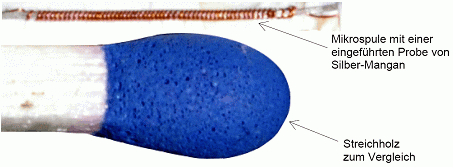Innovations ● Measurement Technique ● Technology Consulting ● Projects

Project miniESR:
The electron spin resonance ESR is concerned with a group of phenomena which is
described as follows: The electronic levels of a paramagnetic system, such as an atom,
ion or molecule split, under certain conditions in a magnetic field. Induced radiative
transitions can be observed between two adjacent levels (~ GHz) as resonance absorption.
The properties of this absorption (intensity, frequency, spectral width, absorption
coefficient, etc.) are dependent on the applied magnetic field, on the individual
properties of the observed system and its environment. A whole range of information
can be provided from the obtained spectra. The sensitivity of modern spectrometers
is such that amounts of substances of about 10-10 g/mol are still easily
detectable at a molecular weight of 100 g/mol *.
 The main application areas are:
The main application areas are:
- Studies on the atomic structure of the transition elements
- Determining the constitution of molecules
- Investigation of the chemical reactions (radical formation and recombination)
- Determining the constitution of centers in solids (donors, color centers, etc.)
- Investigations of magnetic systems for determination of the g-factor, relaxation, etc.
- Investigation of the effects of radiation (void formation) and its damages (e. g. canned food)
- Detection of small amounts of substances
- Dose of radioactivity and electron beams (for studying the wear of automobile tires)
- Medicine (e. g. diagnosis of skin cancer, study of DNA and hemoglobin structure)
- Pharmaceutical industry (e. g. quality tests on the sunscreen)
- Environmental Analysis: Investigation of forest damage by means of ESR spectroscopy on the plant leaves.
The conventional ESR spectroscopy control, in spite of its barely surpassing sensitivity, has not prevailed for industrial process. The current ESR technique is very expensive and complex, its spectrometers are heavy and bulky. The ESR could play in process control, continuous measurements, quality control and environmental analysis (in stations) an important role, if the existing economic and operating problems were not available.
The aim of the miniESR project is, using the non-resonant microcoil technique, to develop a compact ESR spectrometer, which allows a quick and proper ESR spectroscopy possible. The system should be in contrast to the conventional ESR spectrometers light, portable and inexpensive. The advantages of the ESR microcoil technique over conventional ESR spectrometers are, among others:
- Flexibility: In many studies it is desirable to perform experiments at several frequencies. This is not feasible with a single type of conventional ESR system. In the microcoil ESR system, however, applying any microwave frequency, even frequency scanning instead of field scanning, is possible.
- Speed in setting up and rebuilding.
- High sensitivity, especially for very small samples (over 400-times increase in sensitivity compared to the conventional method). This property must be emphasized, since in many applications (e. g. for trace analysis), only a small amount of sample to be tested is available.
- Low cost: Possible use of very small and light electromagnet of diameter < 3 cm (in the conventional method of > 20 cm). No expensive cavity resonators and wave guides. No significant problems with the power supply or cooling of the electromagnet, resulting in energy savings. Through the implementation of a commercial microcoils ESR spectrometer, the total cost of an ESR spectrometer can be reduced by more than three times, while its quality and experimental possibilities are multiplied. Thus, the ESR will stay no longer a monopoly of the major research institutes!
*) From "Lehrbuch der Experimentalphysik-Aufbau der Materie", Bergmann-Schaefer, Band IV, S. 541, Walter der Gruyer (1981).

